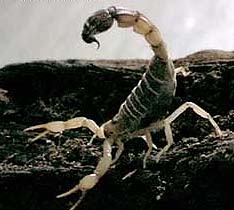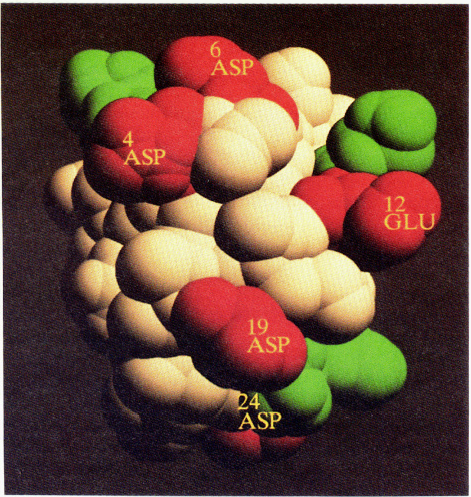
Androctonus australis
Iberiotoxin
| The Scorpion | Poisoning | Chemical Structure | Interesting Facts | Bibliography |
Iberiotoxin is most commonly found in the deadliest of Scorpion species such as Androctonus australis and Buthus occitanus. These scorpions are native to the Middle East and North Africa. They can live in a range of environments including deserts, savannahs, grasslands, deciduous forests, caves, and rainforests. There are about 1,500 known species of scorpions in the world ranging from 0.5 to 10 inches long. During the day they rest in an underground burrow only to feast on insects and spiders at night. Prior to mating, the male and female hold each other's claw and perform a courtship dance. Also interesting to note is that the female gives birth to live young and then carries them on her back for a month before they go off on their own. In terms of evolution, curiously it seems that the scorpion has changed very little since its emegence 400 million years ago.[1]
The general rule of thumb for the potency of a Scorpion's venom is that one's with a large tail and small pincers have the strongest venom. Interestingly, scorpions with powerful pincers and a thin tail use venom as their secondary defense mechanism. In general, an average scorpion's sting will result in a mild inflammatory reaction in addition to the intense pain of the sting itself. However if a dangerous scorpion such as a buthid stings you, it may be fatal especially for young children or the elderly.
Symptoms include:
- Drooling
- Raised blood pressure
- Hyperactive tendon reflexes
- Respiratory Failure
- Tremors
- Dysphagia
- Convulsions
Treatment
This is a general procedure and varies from scorpion to scorpion. After immobilizing and cleaning the wound, crushed ice is applied to the sting site. Aspirin is given and then lignocine is locally injected to ease the pain. Raised blood pressure is counteracted with calcium blocking agents. If venom was sprayed into the eyes, the scorpion's antivenom is used in solution to lavage the eyes. Also, treat the symptoms as they appear such as tremors or dysphagia as they appear since there is no antivenom.[2]
 Space filling model of Iberiotoxin with positive residues in green and negative ones in red.[3] Permission Pending, Requested 2/22/04 Source: Biochemistry. 1992 Sep 8;31(35):8151-9 |
Iberiotoxin is a very effective Ca2+ and K+ channel blocker as determined by NMR spectroscopy. Often abreviated as IbTX, iberiotoxin is structurally similar to Charybdotoxin except that IbTX cause channel blockage for significantly longer period of time. Its has a net charge of +1, which is important when considering its binding ability and surface electrostatics. There are disulfide bonds from residues 7 to 28, 13 to 33, and 17 to 35. The disulfide bridging presents the same profile as in other scorpion toxins. As to my knowledge the toxin has not been synthesized from scratch, although it has been modified. Because iberiotoxin is a very potent and selective blocker of these ion channels, it is sold for this very purpose. There is no available antidote at this time. The neurotoxin was first isolated and studied in detail in 1990 by the Merck Institute for Therapeutic Research in New Jersey. The group isolated iberiotoxin using a combination of ion exchange and reversed-phase chromatography.[5] |
- Iberiotoxin can be bought at this site, AccurateChemical, for $111 for 10 micrograms.
- Scorpions are mostly immune to their own poison, contrary to popular belief.[4]
- Scorpions can live for up to 5 years.
- They are nocturnal animals and feed on insects including other scorpions.
- Some species fluoresce under ultraviolet light.[6]
1. Fun Facts, http://www.tooter4kids.com/Desert/fun_facts.htm, Accessed: 2/24/04
2. Leanard Schrire, Gert J. Muller, Liron Pantanowitz, South African Institute for Medical Research, 1996, The diagnosis and treatment of envenomation on South Africa.
3. Johnson, B and Sugg, E. Biochemistry. 1992 Sep 8;31(35):8151-9, Determination of the Three-Dimensional Structure of Iberiotoxin in Solution by l H Nuclear Magnetic Resonance Spectroscopy.
4. Legros, C, et. al, The Journal of Experimental Biology. 1998 201, 2625-2636. THE MYTH OF SCORPION SUICIDE: ARE SCORPIONS INSENSITIVE TO THEIR OWN VENOM?.
5. Galvez, A, et. al, The Journal of Biological Chemistry. 1990. 265(19):11083-90, Purification and Characterization of a Unique, Potent, Peptidyl Probe for the High Conductance Calcium-activated Potassium Channel from Venom of the Scorpion Buthus tamulus.
6. Creature Feature: Scorpions, http://www.desertmuseum.org/kids/features_scorpions.html, Accessed: 2/24/04
Additional References due to Web Searching Homework:
Kathleen M. Giangiacomo, Maria L. Garcia, Owen B. McManusBiochemistry. 1992 Sep 8;31(29):6719-27, Mechanism of iberiotoxin block of the large-conductance calcium-activated potassium channel from bovine aortic smooth muscle
Lu, Z.; MacKinnon, R.Biochemistry. 1997 Apr 16;36(23):6936-40, Purification, Characterization, and Synthesis of an Inward-Rectifier K+ Channel Inhibitor from Scorpion Venom
Back to the Top